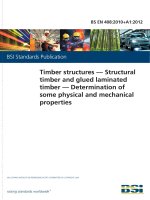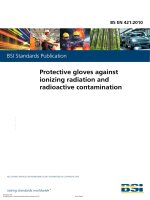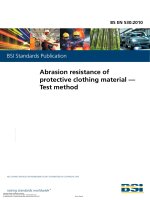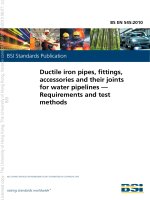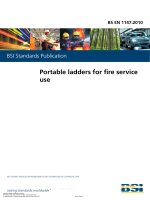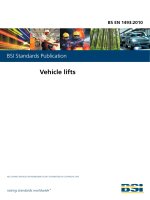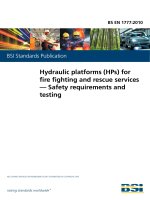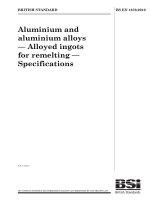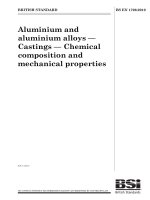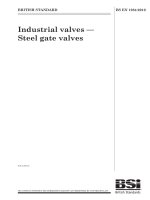Bsi bs en 15851 2010
Bạn đang xem bản rút gọn của tài liệu. Xem và tải ngay bản đầy đủ của tài liệu tại đây (225.51 KB, 18 trang )
!,-.-"/#".0%10,1
2334567885#9
1:6:;<=>?6=3>#38
?8@?63A=>#!&#=>#B:;:?@
C?5:4#83345#83;#=>8?>65
?>4#D37>E#BF=@4;:>
9#/GHI#<:6F34
J=6F#=<<7>3?88=>=6D
B3@7<>#B@:?>7K#?>4
8@73;:5B:>B:#4:6:B6=3>
!"#$%&'(%(
)*$"*+,!)-$.!/0*1/$2#!$+345!##!*)$36"3+/$7#$+345!//38$2,$"*+,4!-0/$97.
!"#$%#&'('&)*+&+
#"%@$%A*(*AB-)A)
$;3971;?%C780D782
!"#$%&'#(#$"%)(*+,*',%#$%("2%BC%#:.12:2+(*(#3+%35%DE%>FGF>H<=>=I%
!"2%BC%.*'(#7#.*(#3+%#+%#($%.'2.*'*(#3+%-*$%2+('/$(2,%(3%!27"+#7*1
93::#((22%JKLML;N%O33,%*+*14$#$%M%P3'#Q3+(*1%:2("3,$I
J%1#$(%35%3'8*+#Q*(#3+$%'2.'2$2+(2,%3+%("#$%73::#((22%7*+%02%30(*#+2,%3+
'2R/2$(%(3%#($%$27'2(*'4I
!"#$%./01#7*(#3+%,32$%+3(%./'.3'(%(3%#+71/,2%*11%("2%+272$$*'4%.'3S#$#3+$
35%*%73+('*7(I%B$2'$%*'2%'2$.3+$#012%53'%#($%73''27(%*..1#7*(#3+I%
E7/=?9;160%D93F%;%#89394F%"3;12;82%6;1173%671C08%9//<193G
C87/%?0:;?%7>?9:;39714H
!"#$%&'#(#$"%)(*+,*',%-*$%
./01#$"2,%/+,2'%("2%
*/("3'#(4%35%("2%)(*+,*',$%
631#74%*+,%)('*(284%
93::#((22%3+%;1 May
<=>=
./012/0134567889:012;%944<02%49160%=<>?96;3971
A*(2%
93::2+($
?%&)@%<=>=
!"#$%&'(%)%*()%+,-(&%)
标准分享网 www.bzfxw.com 免费下载
BS EN 15851:2010
EUROPEAN STANDARD
EN 15851
NORME EUROPÉENNE
EUROPÄISCHE NORM
April 2010
ICS 67.060
English Version
Foodstuffs - Determination of aflatoxin B1 in cereal based foods
for infants and young children - HPLC method with
immunoaffinity column cleanup and fluorescence detection
Produits alimentaires - Dosage de l'aflatoxine B1 dans les
produits pour nourrissons et jeunes enfants à base de
céréales - Méthode de chromatographie liquide haute
performance avec purification sur colonne d'immunoaffinité
et détection par fluorescence
Lebensmittel - Bestimmung von Aflatoxin B1 in Säuglingsund Kleinkindernahrung auf Getreidebasis - HPLCVerfahren mit Reinigung an einer Immunoaffinitätssä
und Fluoreszenzdetektion
This European Standard was approved by CEN on 27 February 2010.
CEN members are bound to comply with the CEN/CENELEC Internal Regulations which stipulate the conditions for giving this European
Standard the status of a national standard without any alteration. Up-to-date lists and bibliographical references concerning such national
standards may be obtained on application to the CEN Management Centre or to any CEN member.
www.bzfxw.com
This European Standard exists in three official versions (English, French, German). A version in any other language made by translation
under the responsibility of a CEN member into its own language and notified to the CEN Management Centre has the same status as the
official versions.
CEN members are the national standards bodies of Austria, Belgium, Bulgaria, Croatia, Cyprus, Czech Republic, Denmark, Estonia,
Finland, France, Germany, Greece, Hungary, Iceland, Ireland, Italy, Latvia, Lithuania, Luxembourg, Malta, Netherlands, Norway, Poland,
Portugal, Romania, Slovakia, Slovenia, Spain, Sweden, Switzerland and United Kingdom.
EUROPEAN COMMITTEE FOR STANDARDIZATION
COMITÉ EUROPÉEN DE NORMALISATION
EUROPÄISCHES KOMITEE FÜR NORMUNG
Management Centre: Avenue Marnix 17, B-1000 Brussels
© 2010 CEN
All rights of exploitation in any form and by any means reserved
worldwide for CEN national Members.
Ref. No. EN 15851:2010: E
BS EN 15851:2010
EN 15851:2010 (E)
Contents
Page
Foreword ..............................................................................................................................................................3!
1!
Scope ......................................................................................................................................................4!
2!
Normative references ............................................................................................................................4!
3!
Principle ..................................................................................................................................................4!
4!
Reagents .................................................................................................................................................4!
5!
Apparatus ...............................................................................................................................................7!
6!
Procedure ...............................................................................................................................................8!
7!
HPLC analysis ........................................................................................................................................9!
8!
Calculation ........................................................................................................................................... 11!
9!
Precision .............................................................................................................................................. 11!
10!
Test report ........................................................................................................................................... 12!
Annex A (informative) Typical chromatogram .............................................................................................. 13 !
Annex B (informative) Precision data............................................................................................................. 14!
Bibliography ..................................................................................................................................................... 15!
www.bzfxw.com
2
标准分享网 www.bzfxw.com 免费下载
BS EN 15851:2010
EN 15851:2010 (E)
Foreword
This document (EN 15851:2010) has been prepared by Technical Committee CEN/TC 275 “Food analysis Horizontal methods”, the secretariat of which is held by DIN.
This European Standard shall be given the status of a national standard, either by publication of an identical
text or by endorsement, at the latest by October 2010, and conflicting national standards shall be withdrawn at
the latest by October 2010.
Attention is drawn to the possibility that some of the elements of this document may be the subject of patent
rights. CEN [and/or CENELEC] shall not be held responsible for identifying any or all such patent rights.
This document has been prepared under a mandate given to CEN by the European Commission and the
European Free Trade Association.
WARNING — The use of this standard can involve hazardous materials, operations and equipment.
This standard does not purport to address all the safety problems associated with its use. It is the
responsibility of the user of this standard to establish appropriate safety and health practices and
determine the applicability of regulatory limitations prior to use.
According to the CEN/CENELEC Internal Regulations, the national standards organizations of the following
countries are bound to implement this European Standard: Austria, Belgium, Bulgaria, Croatia, Cyprus, Czech
Republic, Denmark, Estonia, Finland, France, Germany, Greece, Hungary, Iceland, Ireland, Italy, Latvia,
Lithuania, Luxembourg, Malta, Netherlands, Norway, Poland, Portugal, Romania, Slovakia, Slovenia, Spain,
Sweden, Switzerland and the United Kingdom.
www.bzfxw.com
3
BS EN 15851:2010
EN 15851:2010 (E)
1
Scope
This European Standard specifies a method for the determination of aflatoxin B1 in baby food by high
performance liquid chromatography (HPLC) with immunoaffinity cleanup and fluorescence detection. This
method has been validated in an interlaboratory study via the analysis of both naturally contaminated and
spiked samples ranging from 0,07 µg/kg to 0,18 µg/kg.
For further information on the validation, see Clause 9 and Annex B.
2
Normative references
The following referenced documents are indispensable for the application of this document. For dated
references, only the edition cited applies. For undated references, the latest edition of the referenced
document (including any amendments) applies.
EN ISO 3696:1995, Water for analytical laboratory use - Specification and test methods (ISO 3696:1987)
3
Principle
A test portion is extracted with a mixture of methanol and water. The extract is filtered, diluted with phosphate
buffered saline (PBS) to a specified solvent concentration, and applied to an immunoaffinity column containing
antibodies specific to aflatoxin B1. Aflatoxin B1 is purified and concentrated on the column and removed from
the antibodies using methanol as eluent. Aflatoxin B1 is quantified by reverse-phase high performance liquid
chromatography (RP-HPLC) with post column derivatization (PCD) involving bromination followed by
fluorescence detection.
www.bzfxw.com
The post column derivatization is achieved with either electrochemically generated bromine or with pyridinium
hydrobromide perbromide (PBPB).
4
4.1
Reagents
General
Use only reagents of recognized analytical grade and water complying with grade 1 of EN ISO 3696:1995,
unless otherwise specified. Solvents shall be of quality for HPLC analysis, unless otherwise specified.
Commercially available solutions with equivalent properties to those listed may be used.
WARNING — Dispose of waste solvents according to applicable environmental rules and regulations.
Decontamination procedures for laboratory wastes have been reported by the International Agency for
Research on Cancer (IARC), see [4].
4.2
Helium purified compressed gas.
4.3
Nitrogen.
4.4
Disodium hydrogen phosphate, Na2HPO4 anhydrous or Na2HPO4·12 H2O.
4.5
Potassium bromide.
4.6
Potassium chloride.
4.7
Potassium dihydrogen phosphate, KH2PO4.
4.8
Sodium chloride.
4
标准分享网 www.bzfxw.com 免费下载
BS EN 15851:2010
EN 15851:2010 (E)
4.9
Sodium hydroxide.
4.10 Hydrochloric acid solution, mass fraction w(HCl) = 37 % in water.
4.11 Hydrochloric acid solution, substance concentration c(HCl) = 0,1 mol/l.
Dilute 8,28 ml of hydrochloric acid solution (4.10) to 1 l with water.
4.12 Sodium hydroxide solution, c(NaOH) = 0,1 mol/l.
Dissolve 4 g of sodium hydroxide (4.9) in 1 l of water.
4.13 Phosphate buffered saline (PBS) solution, c(NaCl) = 120 mmol/l, c(KCl) = 2,7 mmol/l, c(phosphate
buffer) = 10 mmol/l, pH = 7,4.
Dissolve 8,0 g of sodium chloride (4.8), 1,2 g of anhydrous disodium hydrogen phosphate or 2,9 g of
Na2HPO4·12 H2O (4.2), 0,2 g of potassium dihydrogen phosphate (4.7) and 0,2 g of potassium chloride (4.6)
in 900 ml of water. After dissolution, adjust the pH to 7,4 with hydrochloric acid solution (4.11) or sodium
hydroxide solution (4.12) as appropriate, then dilute to 1 l with water.
Alternatively, a PBS solution with equivalent properties can be prepared from commercially available PBS
material.
4.14 Pyridinium hydrobromide perbromide (PBPB), [CAS: 39416-48-3].
4.15 Acetonitrile.
www.bzfxw.com
WARNING — Acetonitrile is hazardous and samples shall be blended using an explosion proof
blender which is housed within a fume cupboard. After blending, samples shall be filtered inside a
fume cupboard.
4.16 Methanol, HPLC grade.
4.17 Methanol, technical grade.
4.18 Toluene.
4.19 Extraction solvent.
Mix eight parts per volume of methanol (4.17) with two parts per volume of water.
4.20 Nitric acid, c(HNO3) = 4 mol/l.
4.21 HPLC mobile phase A, for use with PBPB.
Mix six parts per volume of water with two parts per volume of acetonitrile (4.15) and three parts per volume of
methanol (4.16). Degas mobile phase A with for example helium (4.2).
4.22 HPLC mobile phase B, for use with electrochemically generated bromine.
Mix six parts per volume of water with two parts per volume of acetonitrile (4.15) and three parts per volume of
methanol (4.16). Add 120 mg of potassium bromide (4.5) and 350 µl of nitric acid (4.20) per litre of mobile
phase. Degas mobile phase B with for example helium (4.2).
4.23 Post-column reagent.
Dissolve 50 mg of PBPB (4.14) in 1 l of water. To be used with mobile phase solvent A (4.21). The solution
may be used up to four days if stored in a dark place at room temperature.
5
BS EN 15851:2010
EN 15851:2010 (E)
4.24 Mixture of toluene and acetonitrile.
Mix nine parts per volume of toluene (4.18) with one part per volume of acetonitrile (4.15).
4.25 Immunoaffinity column.
The immunoaffinity column shall contain antibodies raised against aflatoxin B1. The column shall have a
capacity of not less than 100 ng of aflatoxin B1 and shall give a recovery of not less than 80 % when 5 ng of
aflatoxin B1 are applied as a standard solution in a mixture of ten parts per volume of methanol and 90 parts
per volume of water.
4.26 Aflatoxin B1, in crystal form or as a film in ampoules or in form of commercially available aflatoxin B1
solution.
WARNING — Aflatoxins are subject to light degradation. Protect the laboratory, where the analyses
are done, adequately from daylight. This can be achieved effectively by using ultraviolet (UV)
absorbing foil on the windows in combination with subdued light (no direct sunlight) or curtains or
blinds in combination with artificial light (fluorescent tubes are acceptable).
Protect aflatoxin containing solutions from light as much as possible (keep in the dark, use aluminium
foil or amber-coloured glassware).
4.27 Aflatoxin B1 stock solution, c ! 10 µg/ml.
Prepare a solution of aflatoxin B1 in the mixture of toluene and acetonitrile (4.24) to give a solution with a
mass concentration of approximately 10 µg/ml.
www.bzfxw.com
To determine the exact mass concentration, record the absorption curve between 330 nm and 370 nm in 1 cm
quartz cells in a spectrometer (5.14) with the mixture of toluene and acetonitrile (4.24) as reference. Identify
the wavelength for maximum absorption (between 330 nm and 370 nm). Calculate the mass concentration of
aflatoxin B1, !afl, in µg/ml, using Equation (1):
ρ afl =
Amax × M × 100
ε ×b
(1)
where
Amax is the absorption determined at the maximum of the absorption curve (between 330 nm and
370 nm);
M
is the molar mass, in g/mol, of aflatoxin B1 (M = 312 g/mol);
!
is the molar absorption coefficient, in square metres per mole, of aflatoxin B1 in the mixture
2
of toluene and acetonitrile (4.24) (1 930 m /mol, see [5]);
b
is the optical path length, in centimetres, of the quartz cell.
Store this solution in a freezer at approximately - 18 °C. Allow to reach room temperature before opening. A
solution stored in this way is usually stable for 12 months. Confirm the concentration of the solution if it is older
than 12 months.
4.28 Aflatoxin B1 standard solution, ! = 5,00 ng/ml.
Pipette a volume of aflatoxin B1 stock solution (4.27) containing exactly 1,00 µg aflatoxin B1 into a 200 ml
calibrated volumetric flask and dilute to the mark with the mixture of toluene and acetonitrile (4.24). This
solution contains 5,00 ng/ml aflatoxin B1.
6
标准分享网 www.bzfxw.com 免费下载
BS EN 15851:2010
EN 15851:2010 (E)
Wrap the flask tightly in aluminium foil and store it at less than 4 °C. Before use, do not remove the aluminium
foil until the contents have reached room temperature to avoid incorporation of water by condensation. A
solution stored in this way is stable for at least four weeks.
4.29 Aflatoxin B1 spiking solution, ! = 2 µg/ml.
Pipette a volume of aflatoxin B1 stock solution (4.27) containing exactly 20 µg aflatoxin B1 into a 10 ml
calibrated volumetric flask. Evaporate the mixture of toluene and acetonitrile solution just to dryness under a
stream of nitrogen at room temperature. Make up to volume with methanol (4.16) and shake well. The
concentration of this spiking solution is 2 µg/ml for aflatoxin B1.
Wrap the flask tightly in aluminium foil and store it at less than 4 °C. Before use, do not remove the aluminium
foil until the contents have reached room temperature to avoid incorporation of water by condensation. A
solution stored in this way is stable for at least three months.
5
Apparatus
WARNING — All glassware coming into contact with aqueous solutions of aflatoxins shall be washed
with acid solution before use. Many laboratory washing machines do this as part of the washing
programme. Otherwise soak laboratory glassware coming into contact with aqueous solutions of
aflatoxins in sulfuric acid (c = 2 mol/l) for several hours (e.g. 15 h overnight), then rinse well (e.g. at
least three times) with water to remove all traces of acid. Check the absence of acid with pH paper.
This treatment is necessary, because the use of non-acid washed glassware can cause losses of
aflatoxins. In practice, the treatment is necessary for round bottomed flasks, volumetric flasks,
measuring cylinders, vials or tubes used for calibration solutions and final extracts (particularly
autosampler vials), and Pasteur pipettes, if these are used to transfer calibration solutions or extracts.
www.bzfxw.com
Usual laboratory glassware and equipment and, in particular, the following.
5.1
Analytical balance, capable of weighing to 0,000 1 g.
5.2
Laboratory balance, capable of weighing to 0,01 g.
5.3
Adjustable vertical or horizontal shaker.
5.4
Filter paper, e.g. 24 cm diameter, prefolded.
5.5
Conical flask, with screw top or glass stopper of 500 ml capacity.
5.6
Glass microfibre filter, retention size 1,6 µm or smaller.
5.7
Reservoir, of 75 ml capacity with luer tip connector and attachments for immunoaffinity column (IAC).
5.8
Hand pump, 20 ml syringe with luer lock or rubber stopper for IAC.
5.9 Volumetric flasks, of 5 ml, 10 ml, 20 ml, 150 ml, and 200 ml capacity with an accuracy of at least
0,5 %.
5.10 Disposable syringe filter unit, with pore size of 0,45 µm.
Prior to usage, verify that no aflatoxin losses occur during filtration (recovery testing).
NOTE
There is a possibility that various filter materials retain aflatoxins.
5.11 Volumetric pipettes, with 2 ml and 10 ml capacity.
5.12 Calibrated microlitre syringe(s) or microlitre pipette(s), with 25 µl to 500 µl capacity.
7
BS EN 15851:2010
EN 15851:2010 (E)
5.13 HPLC apparatus comprising the following:
5.13.1 Injection system, capable of injecting e.g. 1 000 µl. Total loop injection is recommended.
In the case that a different volume is used, it shall be ensured that the limit of detection (LOD) for the system
is " 0,05 µg/kg (signal-to-noise-ratio = 3) and the limit of quantification (LOQ) is " 0,1 µg/kg for aflatoxin B1.
The measurement of the LOQ shall be performed by multiple injection (n = 10) of a standard solution of
aflatoxin B1 (concentration equivalent to a contamination level of 0,1 µg/kg). The relative standard deviation
(RSD) of the obtained signals shall not exceed a value of 10 %. This data shall be reported.
5.13.2 Mobile phase pump, capable of maintaining a volume flow rate of 1,0 ml/min.
5.13.3 Fluorescence detector, with a wavelength of # = 360 nm excitation filter and a wavelength of
# > 420 nm cut-off emission filter, or equivalent (e.g. a detector with an adjustable monochromator).
5.13.4 Recorder, integrator or computer based data processing system.
5.13.5 Analytical reverse-phase HPLC separating column, e.g. C18 or ODS-2, and a suitable
corresponding reverse phase guard column.
This column shall ensure a baseline resolved resolution of the aflatoxin B1 peak from all other peaks. The
maximum overlapping of peaks shall be less than 10 % of the maximum peak height. It could be necessary to
adjust the mobile phase for a sufficient baseline resolution. A suitable pre-column should be used.
5.13.6 Post-column derivatization system, with PBPB (only to be used with mobile phase A, see 4.21).
Consisting of a second HPLC pulseless pump, zero-dead volume T-piece, reaction tubing of
polytetrafluoroethylene (PTFE) with minimum 45 cm length and 0,5 mm internal diameter.
www.bzfxw.com
®
5.13.7 System for derivatization with electrochemically generated bromine, e.g. KOBRA cell 1) (only to
be used with mobile phase B, see 4.22).
Recommended settings for adjustable detectors are 365 nm (excitation wavelength), 435 nm (emission
wavelength) and a bandwidth of 18 nm.
5.13.8 Degasser (optional).
5.14 UV spectrometer, with suitable quartz cells.
6
6.1
Procedure
Extraction
Mix the sample thoroughly before removing an analytical test portion.
Weigh, to the nearest 0,1 g, 50 g of the test portion of baby food (infant formula) into a 500 ml conical flask
(5.5). Add 5 g of sodium chloride (4.8) and 250 ml of extraction solvent (4.19). Shake intensively by hand for
the first 15 s to 30 s and then for 30 min with a shaker (5.3). Filter the extract using a prefolded filter paper
(5.4) and, using a pipette (5.11), pipette 10 ml of the clear filtrate into a 100 ml calibrated volumetric flask (5.9)
and fill up with PBS (4.13) to the mark. Re-filter through a glass microfibre filter (5.6) and transfer a volume of
®
1) KOBRA cell is a trade name of a suitable product available commercially. This information is given for the
convenience of users of this European Standard and does not constitute an endorsement by CEN of the product named.
Equivalent products may be used if they can be shown to lead to the same results.
8
标准分享网 www.bzfxw.com 免费下载
BS EN 15851:2010
EN 15851:2010 (E)
50 ml to 100 ml of the clear filtrate on a reservoir (5.7) that is placed on a conditioned immunoaffinity column
(see 4.25). Transfer the solution on column as described in 6.2.
6.2
Immunoaffinity column cleanup
The cleanup may be carried out by using a vacuum, by positive pressure or by allowing the specified volumes
to pass through the column under gravity. Do not exceed the maximum specified flow rates. Extra care is
needed to ensure this when a vacuum manifold is used.
Prepare the immunoaffinity column (4.25) according to the manufacturers' instructions, with special attention
for avoiding column drying, if specified. Columns should be allowed to reach room temperature prior to
conditioning.
Pass the filtrate through the column at a flow rate of approximately 3 ml/min (approximately 1 drop/s). Do not
exceed a flow rate of 5 ml/min. Wash the column with approximately 15 ml of PBS (4.13), applied in little
portions of approximately 5 ml at a flow rate of maximum 5 ml/min and dry by applying little vacuum for 5 s to
10 s or by passing air through the immunoaffinity column by means of a syringe for 10 s.
6.3
Preparation of the sample test solution
Elute the aflatoxin B1 by transferring 0,50 ml of methanol (4.16) on the column and let it pass through by
gravity. Collect the elute in a calibrated volumetric flask of 5 ml (5.9).
Wait for 1 min and transfer a second portion of 0,75 ml methanol (4.16) on the column. Collect as much of the
extract as possible by pressing air through. Fill the flask to the mark with water and shake well. If the solution
is clear it can be used directly for HPLC analysis. If the solution is not clear, pass it through a disposable filter
unit (5.10) prior to HPLC injection.
NOTE
Methods for loading onto immunoaffinity columns, washing the column and elution vary slightly between column
manufacturers and the specific instructions supplied with the columns should be followed.
6.4
Spiking procedure
For the determination of the recovery, carry out a spiking procedure using a methanol spiking solution (4.29).
The spiking level shall be within the calibration range (preferably at the value corresponding at the mid range
of the calibration curve). Take care that not more than 2 ml (5.11) of the spiking solvent is added and that the
subsequent evaporation takes place in the dark and should last about 0,5 h to 2 h.
7
7.1
HPLC analysis
HPLC operating conditions
Aflatoxin B1 is separated by isocratic reverse-phase high performance liquid chromatography (RP-HPLC) at
ambient temperature with a reverse-phase column (5.13.5) and appropriate mobile phase (see 4.21 or 4.22).
The injection volume is 1 000 µl (to ensure a maximum precision total loop mode (see 5.13.1) according to the
instructions of the HPLC injection valve or injection port manufacturer is advisable). The recommended flow
rate is 1 ml/min for a column with an inner diameter of 4,6 mm. Other column dimensions may be used,
provided that the required limit of quantification is achieved. This shall be demonstrated. Thus the flow rate
may be adjusted according to the column dimension.
Aflatoxin B1 elutes with retention time of approximately 11 min and should be baseline resolved from any
interfering substances, if present. The mobile phase may be adjusted by addition of water, methanol (4.16) or
acetonitrile (4.15) for maximum peak resolution and performance. A typical chromatogram is enclosed in
Annex A.
9
BS EN 15851:2010
EN 15851:2010 (E)
7.2
Post-column derivatization
When using PBPB, mount the post-column derivatization system (see 5.13.6), and then operate using the
following parameters:
flow rate of 1,0 ml/min for the mobile phase;
flow rate of 0,30 ml/min for the derivatization reagent (flow rate can be adjusted to the flow rate of the
mobile phase).
®
When using electrochemically generated bromine (KOBRA cell 2)) follow the instructions for the installation of
the cell as supplied by the manufacturers and operate using the following parameters:
flow rate of 1,0 ml/min for the mobile phase;
current of 100 µA.
7.3
Preparation of calibration solutions for HPLC
Pipette from the aflatoxin B1 standard solution (4.28) the volumes as listed in Table 1 into a set of 10 ml
calibrated volumetric flasks, then evaporate the mixture of toluene and acetonitrile solution just to dryness
under a stream of nitrogen at room temperature. To each flask, add 3,5 ml of methanol (4.16), let the aflatoxin
B1 dissolve, dilute to 10 ml with water, and shake well. These solutions cover the range of 0,05 µg/kg to
0,35 µg/kg for aflatoxin B1 under the conditions of this protocol.
NOTE
Methanol and water are subject to volume contraction when mixed.
Table 1 — Preparation of HPLC calibration solutions
HPLC calibration solution
Aliquot taken from aflatoxin B1
standard solution,
! = 5,00 ng/ml
(see 4.28)
Final aflatoxin B1 mass
concentration in calibration
solution
ng/ml
µl
1
20
0,01
2
40
0,02
3
60
0,03
4
80
0,04
5
100
0,05
6
120
0,06
7
140
0,07
The preparation of the calibration solutions can be performed either by the use of pipettes or calibrated
glassware as available.
®
2) KOBRA cell is a trade name of a suitable product available commercially. This information is given for the
convenience of users of this European Standard and does not constitute an endorsement by CEN of the product named.
Equivalent products may be used if they can be shown to lead to the same results.
10
标准分享网 www.bzfxw.com 免费下载
BS EN 15851:2010
EN 15851:2010 (E)
7.4
Calibration curve
Prepare a calibration curve by injecting 1 000 µl of the calibration solutions listed in Table 1 into the HPLC
system at the beginning of every day of the analysis. Plot the peak area against the mass of the injected
aflatoxin B1 and check the curve for linearity.
Prepare appropriate calibration curves in case that the content of aflatoxin B1 in the sample is outside of the
calibration range. Alternatively the injection solution for HPLC analysis can be diluted to an aflatoxin B1
content appropriate for the established calibration curve.
7.5
Determination of aflatoxin B1 in sample test solutions
Inject aliquots of the sample test solution (6.3) into the HPLC system using the same conditions used for the
preparation of the calibration curve.
7.6
Confirmation of aflatoxin B1
In order to confirm aflatoxin B1 disconnect the HPLC column from the bromination device and connect it
directly to the fluorescence detector. The aflatoxin B1 signal is significantly lower (factor 10 or more) when the
derivatization system is removed. Do not switch off the electrical current with the bromination device still in line
due to the possibility of remaining bromine in the cell membrane of the device.
Alternatively, mass spectrometric identification could be applied by performing LC-MS or LC-MS/MS analysis.
8
Calculation
Determine from the calibration curve the mass concentration of aflatoxin B1, in nanograms per millilitre
(ng/ml), in the injection solution. Calculate the mass fraction, wafla, of aflatoxin B1 in nanograms per gram
(ng/g), using Equation (2):
w afla =
ρ afla × V1 × V3
V2 × m s
(2)
where
9
9.1
"afla
is the concentration of aflatoxin B1, in nanograms per millilitre, in the test solution injected and
derived from the calibration curve;
V1
is the volume, in millilitres, of the solvent taken for extraction (here: 250 ml);
V2
is the volume, in millilitres, of the undiluted aliquot of sample extract taken for immunoaffinity
cleanup (here: 5 ml to 10 ml);
V3
is the volume, in millilitres, obtained after elution from the immunoaffinity column (here: 5 ml);
ms
is the mass, in grams, of sample material taken for analysis (here: 50 g).
Precision
General
Details of the interlaboratory test on the precision of the method are given in Table B.1. The values derived
from this interlaboratory test may not be applicable to analyte concentration ranges and matrices other than
given in Annex B.
11
BS EN 15851:2010
EN 15851:2010 (E)
9.2
Repeatability
The absolute difference between two single test results found on identical test material by one operator using
the same apparatus within the shortest feasible time interval will exceed the repeatability limit r in not more
than 5 % of the cases.
The values for baby food (infant formula) are:
x = 0,10 µg/kg
r = 0,011 µg/kg
(fortified)
x = 0,18 µg/kg
r = 0,067 µg/kg
(fortified)
x = 0,07 µg/kg
r = 0,028 µg/kg
x = 0,09 µg/kg
r = 0,020 µg/kg
x = 0,17 µg/kg
r = 0,059 µg/kg
9.3
Reproducibility
The absolute difference between two single test results found on identical test material reported by two
laboratories will exceed the reproducibility limit R in not more than 5 % of the cases.
The values for baby food (infant formula) are:
x = 0,10 µg/kg
R = 0,034 µg/kg
(fortified)
x = 0,18 µg/kg
R = 0,118 µg/kg
(fortified)
x = 0,07 µg/kg
R = 0,048 µg/kg
x = 0,09 µg/kg
R = 0,022 µg/kg
x = 0,17 µg/kg
R = 0,109 µg/kg
10 Test report
The test report shall contain the following data:
a)
all information necessary for the identification of the sample (kind of sample, origin of sample,
designation);
b)
reference to this European Standard;
c)
date and type of sampling procedure (if known);
d)
date of receipt;
e)
date of test;
f)
test results and the units in which they have been expressed;
g)
any particular points observed in the course of the test;
h)
any operations not specified in the method or regarded as optional, which might have effected the results.
12
标准分享网 www.bzfxw.com 免费下载
BS EN 15851:2010
EN 15851:2010 (E)
Annex A
(informative)
Typical chromatogram
Key
X time (min)
Y fluorescence (mV)
1 aflatoxin B1
Operating conditions:
®
Column:
Flow rate:
Mobile phase:
LC-18 Supelcosil 3) , inner diameter 4,6 mm, length 25 cm
1 ml/min
HPLC mobile phase B, see 4.22
Column temperature:
Room temperature
Injection volume:
Derivatization:
1 000 µl
Electrochemically generated bromine
Detection:
Fluorescence, 365 nm excitation, 435 nm emission, bandwidth 18 nm
Figure A.1 — Typical chromatogram of aflatoxin B1 in infant formula after immunoaffinity cleanup
(contamination level 0,1 àg/kg aflatoxin B1)
3) Supelcosilđ is a trade name of a suitable product available commercially. This information is given for the convenience
of users of this European Standard and does not constitute an endorsement by CEN of the product named. Equivalent
products may be used if they can be shown to lead to the same results.
13
BS EN 15851:2010
EN 15851:2010 (E)
Annex B
(informative)
Precision data
The following data (see Table B.1) were obtained in an interlaboratory study organized by the European
Communities, Standards Measurement and Testing Programme [6] in accordance with ISO 5725-2 [1],
ISO 5725-4 [2] and ISO 5725-6 [3]. The test samples were baby food (infant formula) both naturally
contaminated and spiked with aflatoxin B1. The limit of quantification has been demonstrated to be 0,05 µg/kg,
depending on the equipment used.
Table B.1 — Precision data interlaboratory study for baby food (infant formula)
1999
1999
1999
1999
Number of laboratories
14
14
14
14
14
Number of sample duplicates
1
1
1
1
1
Number of laboratories retained after eliminating
outliers
11
14
14
11
13
Number of outliers (laboratories)
3
0
0
3
1
Number of accepted results
11
14
14
11
13
Mean value, x , µg/kg
0,10
0,18
0,07
0,09
0,17
Repeatability standard deviation sr, µg/kg
0,004
0,024
0,010
0,007
0,021
3,5
13
14
8
12
Repeatability limit r [r = 2,8 × sr ], µg/kg
0,011
0,067
0,028
0,020
0,059
Reproducibility standard deviation sR, µg/kg
0,012
0,042
0,017
0,008
0,039
Reproducibility relative standard deviation,
RSDR, %
12
23
23
9
23
Reproducibility limit R [R = 2,8 ì sR], àg/kg
0,034
0,118
0,048
0,022
0,109
Recovery, %
101
92
-
-
-
HorRat value, according to [7]
0,19
0,39
0,34
0,14
0,39
HorRatR value, according to [8]
0,55
1,05
1,01
0,41
1,05
a
14
Naturally contaminated.
标准分享网 www.bzfxw.com 免费下载
5
a
1999
Repeatability relative standard deviation, RSDr, %
4
a
2
Year of interlaboratory test
3
a
1
Sample
BS EN 15851:2010
EN 15851:2010 (E)
Bibliography
[1]
ISO 5725-2, Accuracy (trueness and precision) of measurement methods and results " Part 2: Basic
method for the determination of repeatability and reproducibility of a standard measurement method
[2]
ISO 5725-4, Accuracy (trueness and precision) of measurement methods and results " Part 4: Basic
methods for the determination of the trueness of a standard measurement method
[3]
ISO 5725-6, Accuracy (trueness and precision) of measurement methods and results " Part 6: Use in
practice of accuracy values
[4]
Castegnaro M.; Barek J.; Fremy J.M.; Lafontaine M.; Sansone E.B.; Telling G.M., Laboratory
decontamination and destruction of carcinogens in laboratory wastes: some mycotoxins. IARC
Scientific Publication No. 113, International Agency for Research on Cancer, Lyon (France), 1991,
p. 63
[5]
Nesheim, S.; Trucksess, M. W.; Page, S. W., Molar absorptivities of aflatoxins B-1, B-2, G(1), and G(2)
in acetonitrile, methanol, and toluene-acetonitrile (9+1) (modification of AOAC official method 971.22):
Collaborative study. Journal of AOAC International, 1999, 82 (2), p. 251-258.
[6]
Stroka, J.; Anklam, E.; Joerissen, U.; Gilbert, J., Immunoaffinity column clean-up with liquid
chromatography using post-column bromination for the determination of aflatoxin B1 in baby food:
Collaborative study. Journal of AOAC International, 2001, 84, p. 1116
[7]
Horwitz, W.; Albert, R., The Horwitz Ratio (HorRat): A useful Index of Method Performance with
Respect to Precision. Journal of AOAC International, 2006, 89, p. 1095-1109
[8]
Thompson M., Recent trends in inter-laboratory precision at ppb and sub-ppb concentrations in
relation to fitness for purpose criteria in proficiency testing, Analyst, 2000, 125, p. 385-386
15
!"#$%
&'('&)*+&+
!"#$%$!&'(')*$"(+,-+&-)$#,)('(.('/,
!",#=8#7<3#=E5313E53E7#E47=/E4L#U/5X#.381/E8=UL3#Y/.#1.314.=EA#!.=7=8<
"74E54.58T#,7#1.383E78#7<3#IJ#Z=3>#/E#874E54.58#=E#$0./13#4E5#47#7<3
=E73.E47=/E4L#L3Z3LT#,7#=8#=E?/.1/.4735#UX#B/X4L#;<4.73.T
012')'/,)
!.=7=8<#"74E54.58#4.3#0154735#UX#4V3E5V3E7#/.#.3Z=8=/ET#I83.8#/Y#!.=7=8<
"74E54.58#835=7=/E8T
,7#=8#7<3#?/E874E7#4=V#/Y#!",#7/#=V1./Z3#7<3#604L=7X#/Y#/0.#1./50?78#4E5#83.Z=?38T
F3#>/0L5#U3#A.473Y0L#=Y#4EX/E3#Y=E5=EA#4E#=E4??0.4?X#/.#4VU=A0=7X#><=L3#08=EA
7<=8#!.=7=8<#"74E54.5#>/0L5#=EY/.V#7<3#"3?.374.X#/Y#7<3#73?
MGG#N+O*+#(::P#:+++T#Q4R)#MGG#N+O*+#(::P#SG++T
!",#/YY3.8#V3VU3.8#4E#=E5=Z=504L#01547=EA#83.Z=?3#?4LL35#[DI"#><=?<#3E80.38
7<47#80U8?.=U3.8#407/V47=?4LLX#.3?3=Z3#7<3#L47387#35=7=/E8#/Y#874E54.58T
!.3',4$)(+,-+&-)
\.53.8#Y/.#4LL#!",C#=E73.E47=/E4L#4E5#Y/.3=AE#874E54.58#10UL=?47=/E8#8455.38835#7/#;087/V3.#"3.Z=?38T#K3L)#MGG#N+O*+#(::P#:++&T#Q4R)#MGG#N+O*+#(::P
S++&#$V4=L)#/.53.8]U8=A./01T?/V#^/0#V4X#4L8/#U0X#5=.3?7LX#08=EA#4#53U=7W?.35=7
?4.5#Y./V#7<3#!",#",E#.381/E83#7/#/.53.8#Y/.#=E73.E47=/E4L#874E54.58C#=7#=8#!",#1/L=?X#7/#8011LX#7<3
!",#=V1L3V3E747=/E#/Y#70EL388#/7<3.>=83#.36038735T
#,5/&6+('/,$/,$)(+,-+&-)
!",#1./Z=538#4#>=53#.4EA3#/Y#=EY/.V47=/E#/E#E47=/E4LC#$0./134E#4E5
=E73.E47=/E4L#874E54.58#7<./0A<#=78#D=U.4.X#4E5#=78#K3?
A=Z3#5374=L8#/E#4LL#=78#1./50?78#4E5#83.Z=?38T#;/E74?7#,EY/.V47=/E#;3E7.3T#K3L)
MGG#N+O*+#(::P#S&&&#Q4R)#MGG#N+O*+#(::P#S+G(#$V4=L)#=EY/]U8=A./01T?/V
"0U8?.=U=EA#V3VU3.8#/Y#!",#4.3#@317#01#7/#5473#>=7<#874E54.58#53Z3L/1V3E78
4E5#.3?3=Z3#80U874E7=4L#5=8?/0E78#/E#7<3#10.?<483#1.=?3#/Y#874E54.58T#Q/.#5374=L8
/Y#7<383#4E5#/7<3.#U3E3Y=78#?/E74?7#`3VU3.8<=1#H5V=E=87.47=/ET#K3L)#MGG#N+O*+
(::P#S++*#Q4R)#MGG#N+O*+#(::P#S++&#$V4=L)#V3VU3.8<=1]U8=A./01T?/V
,EY/.V47=/E#.3A4.5=EA#/EL=E3#4??388#7/#!.=7=8<#"74E54.58#Z=4#!.=7=8<#"74E54.58
\EL=E3#?4E#U3#Y/0E5#47#<771)WW>>>TU8=A./01T?/VW!"\D
Q0.7<3.#=EY/.V47=/E#4U/07#!",#=8#4Z4=L4UL3#/E#7<3#!",#>3U8=73#47#<771)WW
>>>TU8=A./01T?/VT
7/83&'4*(
!",#-./01
2345604.73.8#9(:
;<=8>=?@#2=A<#B/45C
D/E5/EC#FG#GHDC#IJ
K3L#MGG#N+O*+#(::P#:++&
Q4R#MGG#N+O*+#(::P#S++&
>>>TU8=A./01T?/VW
874E54.58
;/1X.=A<7#80U8=878#=E#4LL#!",#10UL=?47=/E8T#!",#4L8/#IJC#/Y#7<3#10UL=?47=/E8#/Y#7<3#=E73.E47=/E4L#874E54.5=a47=/E#U/5=38T#$R?317#48
13.V=7735#0E53.#7<3#;/1X.=A<7C#b38=AE8#4E5#[473E78#H?7#&:((#E/#3R7.4?7#V4X
U3#.31./50?35C#87/.35#=E#4#.37.=3Z4L#8X873V#/.#7.4E8V=7735#=E#4EX#Y/.V#/.#UX#4EX
V34E8#c#3L3?7./E=?C#1=7</07#1.=/.#>.=773E
13.V=88=/E#Y./V#!",T
K<=8#5/38#E/7#1.3?L053#7<3#Y.33#083C#=E#7<3#?/0.83#/Y#=V1L3V3E7=EA#7<3#874E54.5C
/Y#E3?3884.X#5374=L8#80?<#48#8XVU/L8C#4E5#8=a3C#7X13#/.#A.453#538=AE47=/E8T#,Y
7<383#5374=L8#4.3#7/#U3#0835#Y/.#4EX#/7<3.#10.1/83#7<4E#=V1L3V3E747=/E#7<3E#7<3
1.=/.#>.=773E#13.V=88=/E#/Y#!",#V087#U3#/U74=E35T
b374=L8#4E5#45Z=?3#?4E#U3#/U74=E35#Y./V#7<3#;/1X.=A<7#4E5#D=?3E8=EA#`4E4A3.T
K3L)#MGG#N+O*+#(::P#S+S+#$V4=L)#?/1X.=A<7]U8=A./01T?/V
标准分享网 www.bzfxw.com 免费下载
